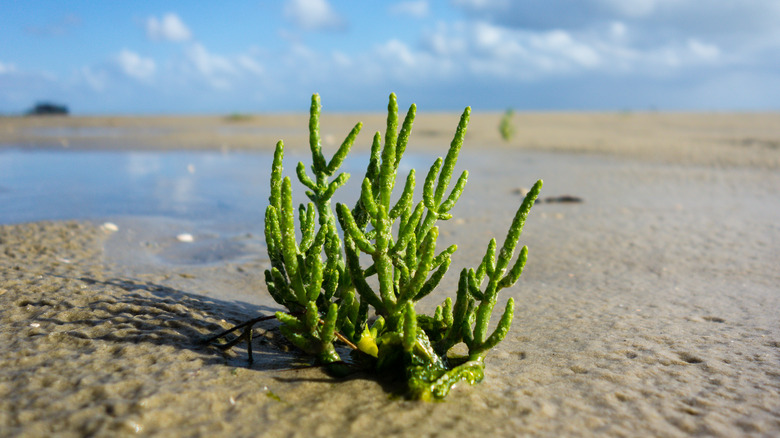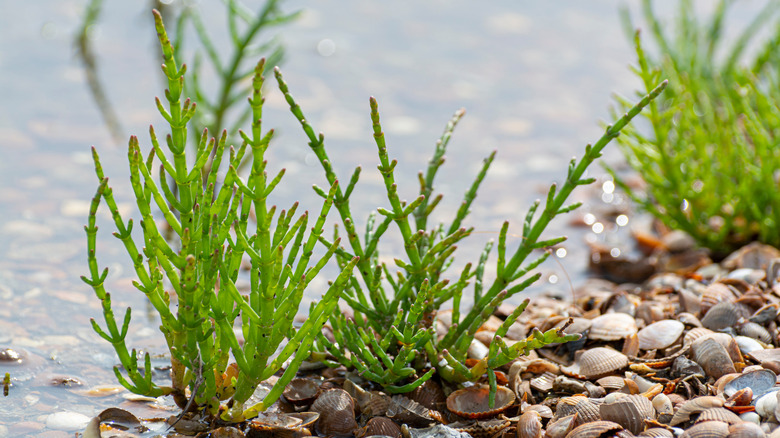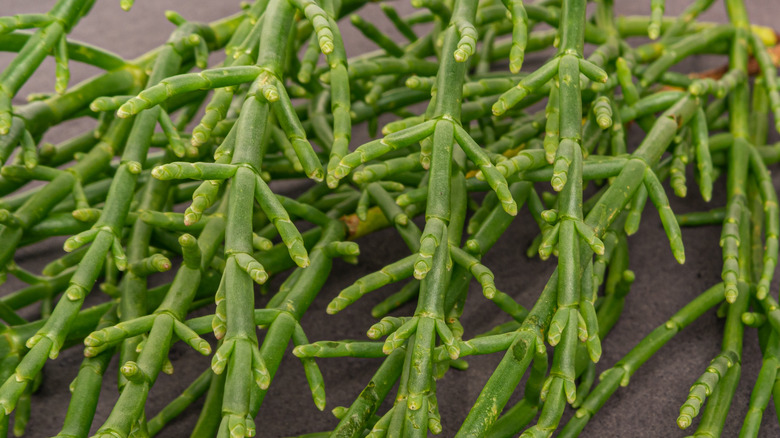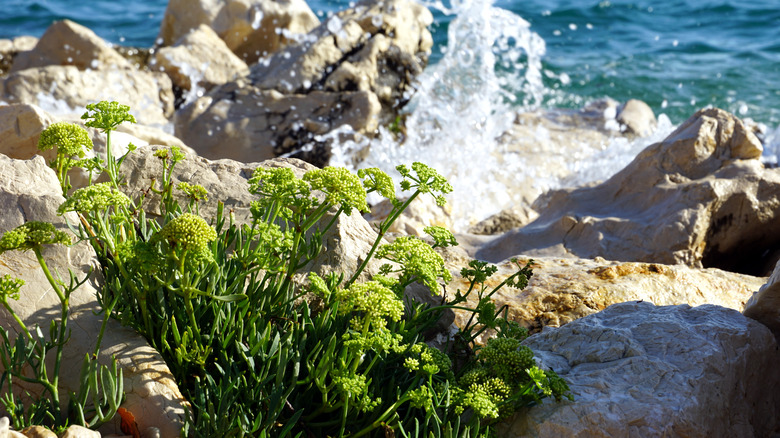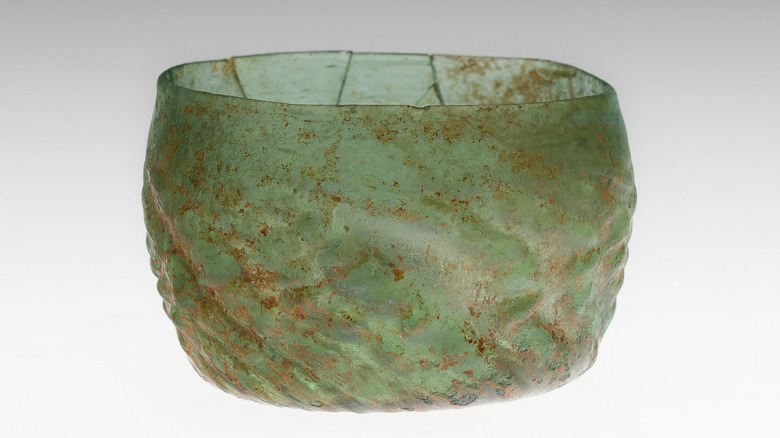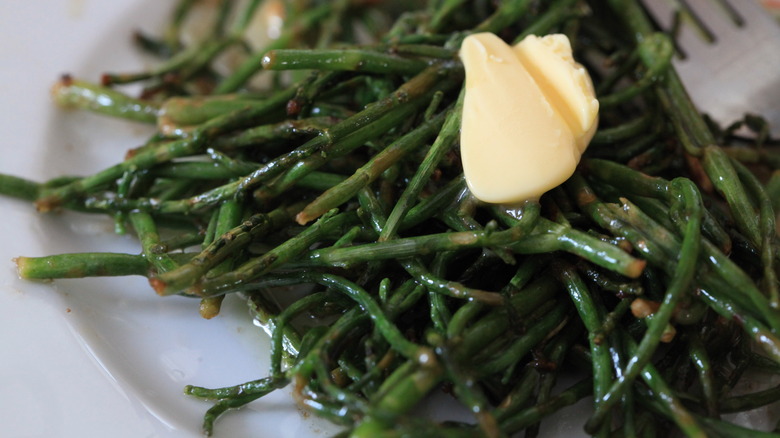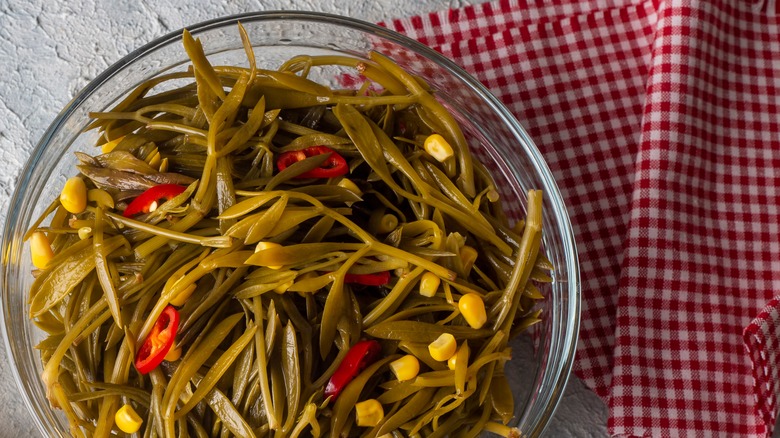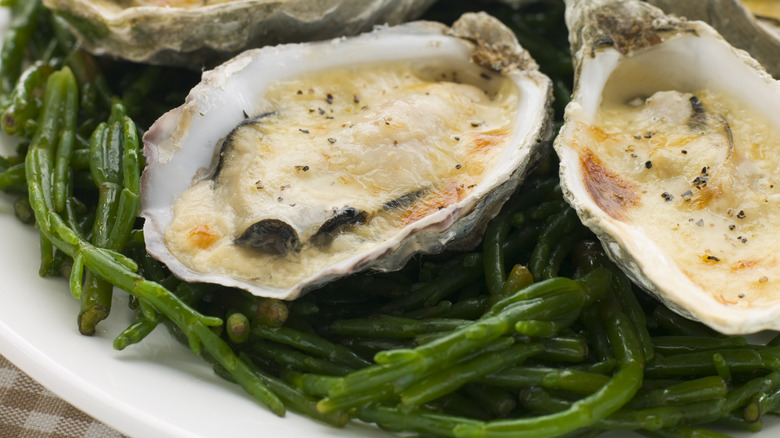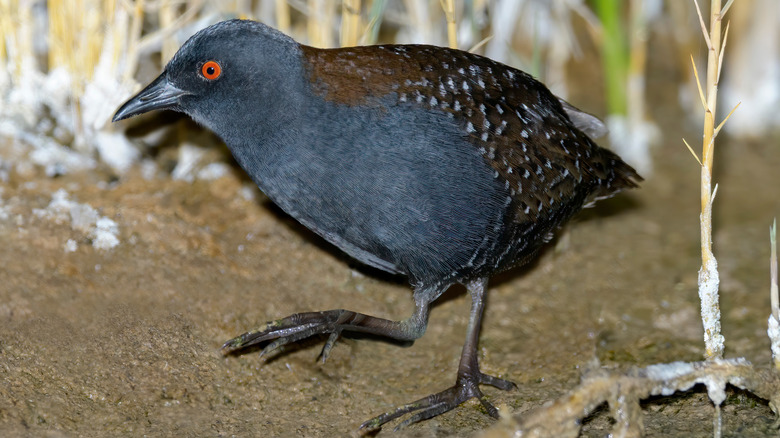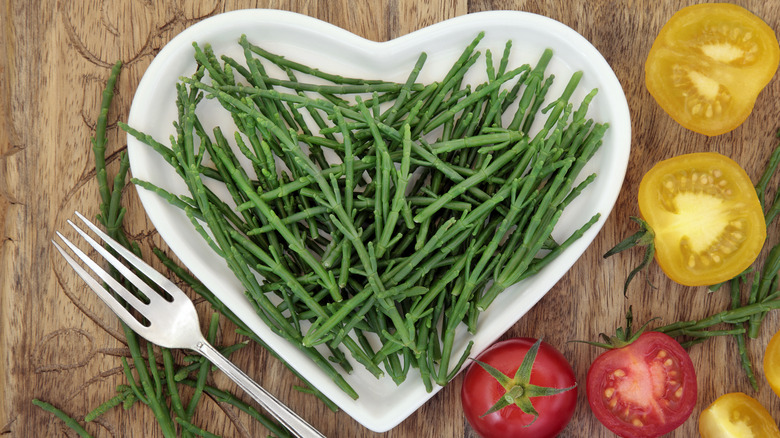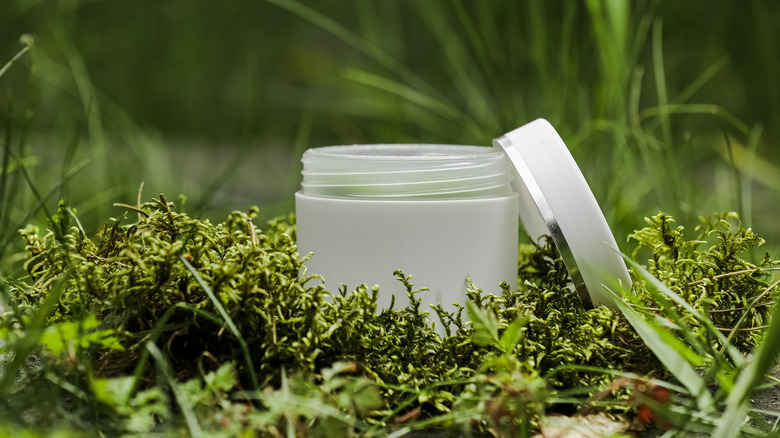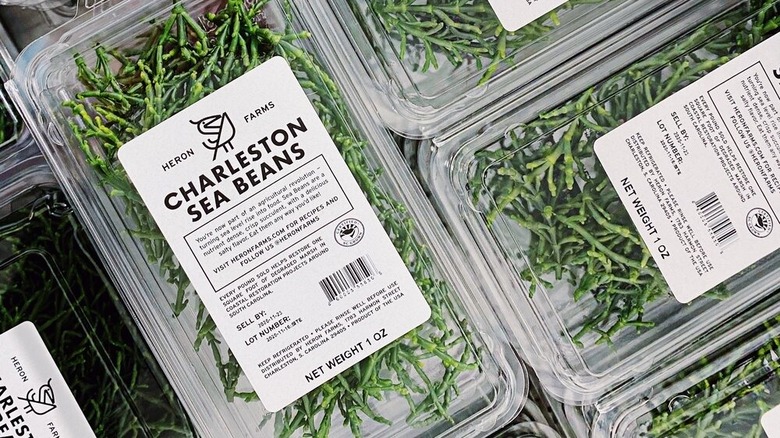The Untold Truth Of Samphire
Striking, salty, and simply incredible to eat by itself or add to delicious recipes, samphire is an amazing vegetable. It grows in the wild in the US, meaning if you live near the coast, you can try your hand at foraging it for your dinner. Alternatively, you can seek it out at a farmer's market if you can't find it at larger stores. With a crispy texture, samphire is reminiscent of the seaside, and also of asparagus in terms of texture and taste (via Culinary Choice).
Samphire is great to eat raw or cooked, especially with seafood and fatty meats, like lamb. It's also a great dish served just by itself because of its distinctive flavor. However, you may not know that there are two different types of samphire, one of which doesn't grow in the US at all. You also might not know about samphire's history as a glassmaking ingredient. Today, it's increasingly being used in the beauty industry, with research into its health benefits ongoing. Samphire helps protects endangered species and could help to protect coastal ecosystems in the future. There's much to learn about the untold truth of samphire, so let's dig in.
Saltwater marsh samphire is a succulent from the sea
Samphire grows in salty, coastal areas, including both coasts in the US. In fact, this green plant actually thrives in these conditions by controlling dehydrating salt in the briny seawater (via Atlas Obscura). The marsh samphire species is categorized as a succulent, per the University of California's Agriculture and Natural Resources Department. The plant has fleshy leaves to help it store water during dry conditions. Some succulents can store water in their stems or roots during arid times, and while they do need water, they can go longer without it because of their succulent nature.
Samphire leaves become bigger during the summer seasons, and this is when they're at their plumpest and ready to be picked. The word "succulent" comes from the Latin word succus, which means juice or sap. Samphire is also a halophyte, which means that it's a plant that's tolerant of salt. The word comes from the Greek for salt, halas, and the Greek word for plant, which is phyton (per Biome Box).
Samphire has many different names
If you haven't heard of samphire or marsh samphire before, then you may know it by a different name, as it has many. For example, it's sometimes called Salicornia, while other monikers include sea asparagus and glasswort. It's also known as sea bean, which is what it's often referred to in the US, but another interesting name for samphire is chicken claws. Each of these names references either the way that samphire looks or one of its properties (via Hurriyet Daily News).
As an edible type of grass, like asparagus, samphire is sometimes called poor man's asparagus because of the similarities, although it is far saltier (via BBC Travel). Other names include pickleweed and picklegrass, and the plant is found in North America, the UK, Europe, and Africa. During the summer, samphire is a vibrant green color with small yellow flowers and stems that have large joints. During the fall, samphire changes to a red or purple color. If you're foraging for samphire, you'll find these plants in marshes and estuaries, rather than anywhere inland (via Morning Chores).
Samphire gets its name from a French saint
With so many different names, you may wonder where the actual word samphire comes from. It is derived from the French name for samphire, which is Herbe de Saint Pierre. In English, Saint Pierre is known as Saint Peter. He's the patron saint of fishermen, as well as fishing nets, and the word samphire is a derivative of the French version of his name. Because samphire grows close to the sea and coastal marshes, it's little surprise that Saint Peter supposedly protects coastlines and those who venture out to sea (via Trinity College Dublin).
There is a similar plant known as rock samphire, which is very different than marsh samphire, but also grows by the sea on the side of cliffs. According to Britannica, Peter was one of the disciples of Jesus in Christian teachings. He was a fisherman before he became a saint and is also recognized as the first pope, according to the Roman Catholic religion.
Rock Samphire is not the same as marsh samphire
Did you know that not all samphire is part of the same plant species? Marsh samphire, which grows naturally in the US and is known scientifically as Salicornia, is what you've most likely come across. It not only looks like asparagus but also has a texture that's a bit like cooked asparagus. Its stems are quite small, with noticeable separations. Samphire has a salty, fresh taste that isn't reminiscent of fish, even though it grows along salty shorelines. Some people think it has a similar taste to seaweed.
Despite sharing part of the same name, rock samphire is not the same as marsh samphire, known scientifically as crithmum. It's far less common and grows on the facades of cliffs in rocky coastal areas, so you won't find it growing in the same place as marsh samphire. It's also part of the carrot family — the way to tell the two samphire species apart is by looking at the stems. Rock samphire does not have segmented stems, and therefore it sports more of a resemblance to antlers. What the two plants have in common, however, is a salty taste, while rock samphire also has a stronger flavor (via Recette Magazine).
Collecting rock samphire was once dangerous
There was once plenty of rock samphire found along Europe's Mediterranean and Atlantic coastlines, the Black Sea, as well as in the UK. This meant that collecting it was a source of income for many poor people who lived by the sea several hundred years ago. However, this wasn't a task for the fainthearted, as foraging for rock samphire was not easy. Amidst inclement weather, the task was somewhat risky, too. Those involved would be attached to ropes, hanging off of cliffs (via Trinity College Dublin). The great English playwright, Shakespeare, even wrote about the perils of collecting rock samphire in King Lear, calling it a "dreadful trade!"
While rock samphire grows wild in rocky areas that benefit from the salty spray from the sea, there's far less of it than there used to be. This is due to development in coastal regions, as well as excessive foraging in the past. As a result, rock samphire is actually protected in certain places, such as Great Britain, as well as Spain's Balearic Islands (via The Metropolitan Museum of Art). The Diario de Calvià reported that local police intervened in Mallorca in 2015 when 10 kilograms of rock samphire were found in bags during a traffic stop.
Glasswort was used to make glass in the Middle Ages
Samphire is sometimes called glasswort, and for good reason. Back in the 14th century, samphire was actually used to make glass. It was such an important ingredient in the process that glassmakers would relocate their glassmaking studios and workshops to coastal regions, where the plant grew naturally — but how was the green plant that grew by the sea turned into glass?
After samphire was collected, a mound of it would be burned to create soda ash, which is another name for sodium carbonate. This ash would then be combined with sand to create glass. Different techniques were used, such as evaporating the caustic soda and leaching the soda ash with lime water. It would then be mixed with sand. It was due to an evolution in production techniques that made the use of samphire obsolete in glassmaking in the early 19th century. A new process that didn't require the plant to obtain the soda ash meant it was simply no longer needed (via Trinity College Dublin).
How to cook marsh samphire
A good tip when preparing any dish with marsh samphire at home is to forage or buy it 2-3 days before eating it, at most — it doesn't last longer than that, even if it's wrapped well in the refrigerator. Its peak seasonal time is during the warmer months (between May and August), and because it's linked with the sea, it's one vegetable that you may find at a fishmonger's stand.
Cooking samphire reduces the salty taste, and you can do this in several ways, from steaming to frying in butter. You can also cook samphire in boiling water for a couple of minutes. According to BBC Good Food, because samphire has such a strongly identifiable taste, it's great served as a side. It can also be incorporated into dishes if you want them to be flavored with the plant, rather than adding salt, or used as a garnish.
Great British Chefs advises rinsing samphire thoroughly before cooking it to get rid of any debris, along with any roots and stems that are too tough to eat when cooked. You can also separate the stems to cook, but make sure you don't add salt to the water if you're blanching it. An appetizing way to serve this succulent is as fried samphire tempura.
Samphire can be eaten raw and pickled
While marsh samphire is usually cooked, it can also be eaten raw too. It can be added to salads, with a good rinse to remove as much of the saltiness as you can. Rock samphire, on the other hand, has a strong odor when it's not cooked. It's not regarded as particularly enjoyable to eat, whether cooked or not, because it has a very distinctive flavor. However, it has traditionally been pickled which greatly improves the taste (via BBC Good Food).
Marsh samphire can also be blanched before it's added to a salad, and a samphire, broad bean and tomato salad recipe by Riverford Organic Farmers, suggests blanching the samphire for just a minute, before plunging it into iced water, and then patting dry. The samphire is added to a dish of roasted cherry tomatoes, with podded broad beans, and homemade croutons, plus a garlic-mayonnaise based dressing. Eat Weeds offers a pickled rock samphire recipe. Put 500 grams of samphire and five thinly sliced banana shallots in brine for 30 minutes, then simmer in fresh boiling water for five minutes, strain, and put into sterilized jars with lids once cool. Heat 500 millilitres of white wine vinegar, 450 grams of sugar, and a quarter teaspoon of ground cloves, plus a teaspoon of ground mace and a tablespoon of black mustard seeds until the sugar's dissolved. Add this to the jars, close, and leave to pickle, preferably for a month at least!
Seafood and samphire pair well
It's not a seaweed, but samphire does grow in the tidal marshes, meaning it goes naturally well with fish and seafood. English celebrity chef, Hugh Fearnley-Whittingstall of River Cottage fame, is a big fan of samphire. He often combines the fresh taste of seafood with some beautifully green samphire (via The Guardian). He suggests that if you're foraging for marsh samphire yourself, just take off the top of the plant by pinching it. The stems are left rooted and can grow again, and it also saves you rinsing time.
One recipe idea is serving samphire with grilled fish, such as a barbequed mackerel. Boil the samphire for 3-4 minutes before draining it. Season it with pepper and serve it with lemon after tossing it in butter and olive oil. To make a salmon pasta and samphire dish, add 500 grams of rinsed samphire to a pan being used to cook 350 grams of spaghetti or linguine. Fry 500 grams of organic salmon or wild sea trout fillets in a little olive oil for a couple of minutes on each side. Flake the cooked fish and remove the bones. Add a knob of butter, a glug of olive oil, and black pepper to the drained samphire and pasta while it's in the hot pan. Toss it together and serve with the fish on top — add a squeeze of lemon juice and a sprinkling of black pepper.
You can grow your own samphire
If foraging for samphire doesn't appeal to you or you live far from the coast, what about trying to grow it yourself? You can do this outside, sowing the seeds in the ground or even in a container. All you need to know is how to sow your samphire seeds, how to look after your samphire plant, and when it's ready to pick and eat.
Victoriana Nursery Gardens says you can begin by covering seeds with compost on a tray between March and May when the temperature is around 77 degrees Fahrenheit. Once the shoots are around an inch high, transfer them into pots, using light soil that drains well. Put them in a sunny spot, whether fully outside or just outside your window. Keep the compost from drying out by watering it with saltwater. Add a teaspoon of sea salt — not table salt — to two cups or 16 fluid ounces of water. Your plant will grow to 2-3 inches, and it will produce seeds for the next season when it turns purple and begins to flower. Protect it from frost so that it survives until the next year. Between June and August is the time to cut your samphire and enjoy it, but make sure to wait a month before you harvest your samphire again.
Endangered species in California are protected by samphire
A feature on samphire in SF Gate highlights how the sometimes-called pickleweed grows wild around San Francisco Bay. The article also reveals how it's not just people who benefit from this green wonder. In fact, the brightly colored plant also plays a significant part in protecting endangered wildlife by providing food and shelter to a mouse that only lives in this part of the country, as well as a bird native to California.
The salt marsh harvest mouse can eat samphire, which may come as a surprise considering the saltiness of the vegetable. These mice are able to tolerate high salt levels and have been seen in the wild chowing down on samphire. Meanwhile, in marshlands, samphire provides a retreat for the Black Rail. This small bird is able to stay protected, only leaving its samphire home when the tide is high. Samphire's integral to conserving the rich biodiversity of the salt marshes and the animals who depend on this diverse and breathtaking habitat.
Samphire has many health benefits
While you're seeking out spectacular samphire recipes, you might like to know that the plant gets a wellness thumbs-up, too. Not only is it fat-free and low in calories, making it a great part of a weight-loss plan, but it's also packed with vitamins, such as A and C, as well as folate. It's an effective digestive aid because it has ample fiber, and it's beneficial for your immune system and bone health as an anti-inflammatory. It's a good source of magnesium as well, which is needed to maintain the body's natural circadian rhythm.
Other essential minerals found in samphire are potassium and calcium. Samphire contains fucoidans, which have been shown to have anti-oxidizing properties, protecting the body from free radicals. Oxidative stress can cause health problems, as well as have an impact on aging, so combating this could make you feel and look better (via Healthy Focus).
Vibrance Magazine explains that the salty flavor of samphire is not from sodium chloride, which can cause health issues, but from ionic minerals that are not harmful to the body unless eaten in large amounts. This means that samphire is a great, salty-tasting food that isn't actually that salty in the traditional sense.
Samphire is a bioactive ingredient in skin products
Not only is samphire good for you, but it's also a bioactive ingredient in beauty products. Greenhouse Beauty advocates for the benefits of samphire for the skin, stating that it's, "a proven botanical that acts like retinol," which has a rejuvenating effect. Other advantages of samphire in beauty products are that it's a sustainable alternative to retinol, as it's renewable and can be replenished fairly quickly. The plant is safe to use for pregnant women, too. It can help block the blue light that comes from laptop and phone screens, and it is good to use on sensitive skin — it contains phyto-vitamin C and doesn't cause inflammation.
An article in CosmeticsDesign highlighted a 2011 study published in the Journal of Cosmetic Dermatology that examined how samphire could impact the epidermis in terms of recovery. This layer of the skin is important in protecting against dehydration and microorganisms that negatively impact the body. The study, which was an experimental pilot, suggested that there could be some "clues" that supported the idea of "samphire cell biomass on the kinetics of epidermal permeability barrier repair." This means samphire could prove to be better for your skin in the future than what has been scientifically proven right now.
The world's first indoor saltwater farm grows samphire
Smithsonian Magazine featured an interesting new development with regard to samphire. In South Carolina, one man is pioneering saltwater agriculture and growing sea beans in a warehouse that is purported to be the world's first indoor saltwater farm. Sam Norton, the owner of Heron Foods, moved on from more traditional agricultural methods, exchanging salt marshes for a 90-square-meter space. His love of samphire came from summers spent foraging for it in the mudflats of Charleston as a child.
Hydroponics, which involves growing plants in water rather than soil, is the primary tactic used. However, because samphire thrives in a salty environment, local fishermen bring in hundreds of liters of seawater to add into the freshwater. As well as being able to produce a year-round crop, the environmentally focused entrepreneur is also looking at how samphire could play a part in coastal restoration. By taking salt out of the soil, samphire could be used to enable other plants to grow on land flooded by saltwater. It could be that in the future, samphire becomes a sustainable savior of coastal lands under threat, not only in the US but everywhere where rising seawater threatens agricultural success and food sustainability.
